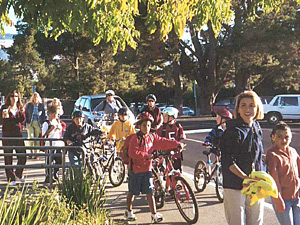|
Audio
Photos
Resources
|
August 2, 2005
President Bush is expected to sign the new federal transportation bill August 10th. The massive $286 billion measure passed by Congress last week is viewed mainly as a major source of jobs for road builders and their suppliers. However pedestrians and bicyclists get something too. Tucked away in the bill is more than half a billion dollars to encourage children to walk or bike to school. The provision is called Safe Routes to School. Pedestrian and bicycle advocates call the measure a major advance for encouraging non motorized traffic in this country and a way to improve childrens' health.
St. Paul, Minn. — Burnsville resident Gary Sjoquist lobbied for the measure. Sjoquist is a cycling lobbyist with Bikes Belong and America Bikes, two advocacy groups. He works for the country's largest distributor of bicycle parts. Besides his monetary self interest in cycling Sjoquist says his other interest is encouraging his 8- and 9-year-old daughters to ride.
"I want them to grow up with choices in how they move their communities and in particular how they get to school. In many cases in America we're busing kids a half mile, a mile, distances that could easily be biked or walked to school," he says.
The new transportation measure sets aside $612 million for safe routes to schools. The money will be doled out to states following a formula based on population but every state guaranteed a base amount.
Some of the money is for educating parents, school officials and traffic engineers how to create safe routes to schools. Several states already have their own program.
One of the most successful is in Marin County near San Francisco. The director, Wendi Kallins, says there are encouraging results from the county's five year old safe route to school program.
"In the last two years we've had a 13-percent reduction in single occupancy vehicles from fall to spring so it shows these kinds of interventions do work. And if you look at some of the other countries where this has been going on, it's still fairly new to the U. S., like England and Canada they have also shown very good results," Kallins says.
More Canadian and British children are walking and biking to school but across the population in Britain -- adults and children -- the overall rate of walking and biking is declining.
Parent Jami Young supports the idea of safe routes to schools but it won't fit her family's routine. She and her children live in Wyoming, north of the Twin Cities, and the kids attend a school miles away. Young says the family is totally reliant on a car for their transportation. However, she's optimistic the federal money can be used to reduce congestion around schools.
"The schools seem to have a similar problem with parking and things so the safe routes could also improve the routes for parents to drop off, pick up , buses also to get in without the children having to cross paths with those vehicles would be much better," she says.
Margaret Sullivan's daughter walks one block to her south Minneapolis elementary school. Sullivan says she and other parents tried for two years to convince city and school officials to cooperate on ways to make it safer for children to walk and bike to school.
"I don't really see it happening. There's too many people involved, county roads, city roads, too complicated and nobody wants to enforce or place speed bumps or other traffic calming measures when frankly it's only congested during the school start time for 15 minutes a day," she says.
The congestion around school buildings is only for a short period. However some traffic studies show that as much as a quarter of some cities morning rush hour traffic is adults driving children to schools.
An experiment two years ago in St. Paul to create safe routes to school was popular, but parents and students complained about bike theft and the lack of secure storage. Another problem was drivers not observing laws protecting pedestrians. Other parents say the safe routes to school idea is limited by weather and by the text books, music instruments and other item many students transport.
Britain and Canada, two countries with advanced safe routes to school initiatives, have addressed safety concerns by recruiting volunteers in pace cars to lead groups of bicyclists and volunteer parents to escort groups of young walkers.
Bicycle advocate Gary Sjoquist credits Minnesota 8th District congressman Jim Oberstar, a Democrat and an avid cyclist, with including the safe routes to school provision in the federal transportation bill.
People have a chance to express their interest in the idea generally on October 5, which is International Walk to School Day.




